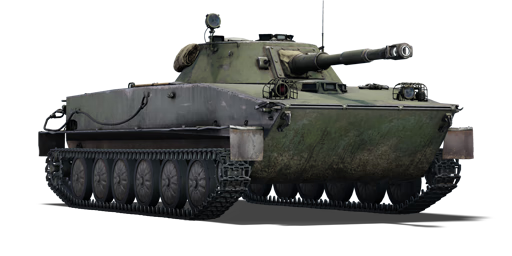



After World War II, the Soviet Army once again resumed its interest in an amphibious light tank design. During the war, they often found themselves lacking a suitable means to transport troops across various water surfaces. Because of this, the Red Army deemed a tank with the ability to cross water with little preparation essential for a planned reconnaissance unit. Two leading tank designers of the USSR at the time, Nikolay Shashmurin and Joseph Kotin, were assigned to develop a new amphibious light tank. The final result of the project was the PT-76, and the tank would later enter production in 1951. The tank's simplistic design later proved to be a success, which spawned numerous variants and derivatives based on the same chassis. These included an airborne assault gun, a self-propelled anti-air vehicle, and an APC. With the chassis of the tank still being produced by the Russian Army, which has developed a modernization of the vehicle that are still in service today.
The PT-76B was an improved variant of the original PT-76, with the addition of a two-plane gun stabilizer, improved fuel capacity, and night vision equipment. This variant of the PT-76 was produced between 1959 and 1961.
Introduced with Update 1.53 "Fire Storm" (although the amphibious feature was not implemented until Update 1.55 "Royal Armour"), the PT-76B is an amphibious light tank developed during the early part of the Cold War. Because of this, it has many features that were considerably anachronistic compared to the majority of World War II-era designs, particularly access to a powerful HEATFS round that can penetrate almost any tank it will face, a two-plane stabilizer, and a night vision (NVD) device. Its amphibious nature means that the tank can cover terrain and paths not normally travelled by land vehicles, allowing for flexibilities on certain maps featuring water bodies. However, this quality is heavily offset by the tank's paper-thin armour that can be easily shredded even by machine guns, along with below-average speed for a light tank. Nevertheless, the PT-76B can still perform nicely in its intended role as the eye for the team and provide fire support when needed.
| Ammunition | Type | Armor penetration (mm) at a distance: | |||||
|---|---|---|---|---|---|---|---|
| 10 m | 100 m | 500 m | 1000 m | 1500 m | 2000 m | ||
| APCR | 152 | 148 | 129 | 109 | 92 | 78 | |
| HE | 13 | 12 | 11 | 10 | 10 | 10 | |
| APHE | 99 | 97 | 89 | 80 | 72 | 65 | |
| HEATFS | 200 | 200 | 200 | 200 | 200 | 200 | |
| Belt | Belt filling | Armor penetration (mm) at a distance: | |||||
|---|---|---|---|---|---|---|---|
| 10 m | 100 m | 500 m | 1000 m | 1500 m | 2000 m | ||
| AP-I/API-T | 13 | 12 | 7 | 3 | 2 | 0 | |












Mobility | |
|---|---|
Protection |
|---|
Firepower | ||
|---|---|---|